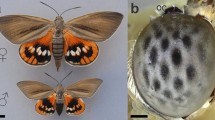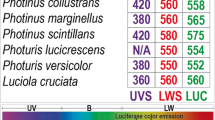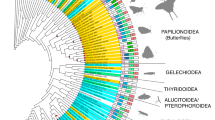Abstract
Flying insects occupy both diurnal and nocturnal niches, and their visual systems encounter distinct challenges in both conditions. Visual adaptations, such as superposition eyes of moths, enhance sensitivity to low light levels but trade off with spatial and temporal resolution. Conversely, apposition eyes of butterflies enable high spatial resolution but are poorly sensitive in dim light. Although diel activity patterns of insects influence visual processing, their role in evolution of visual systems is relatively unexplored. Lepidopteran insects present an excellent system to study how diel activity patterns and phylogenetic position influence the visual transduction system. We addressed this question by comparing electroretinography measurements of temporal response profiles of diverse Lepidoptera to light stimuli that were flickering at different frequencies. Our data show that the eyes of diurnal butterflies are sensitive to visual stimuli of higher temporal frequencies than nocturnal moths. Hesperiid skippers, which are typically diurnal or crepuscular, exhibit intermediate phenotypes with peak sensitivity across broader frequency range. Across all groups, species within families exhibited similar phenotypes irrespective of diel activity. Thus, Lepidopteran photoreceptors may have diversified under phylogenetic constraints, and shifts in their sensitivity to higher temporal frequencies occurred concomitantly with the evolution of diurnal lifestyles.



Similar content being viewed by others
Abbreviations
- ERG:
-
Electroretinogram
- FFF:
-
Flicker fusion frequency
- CI:
-
Confidence interval
References
Autrum H (1958) The electrophysiological analysis of the visual system in insects. Anim Behav 6:118–119. https://doi.org/10.1016/0003-3472(58)90028-9
Cosens D, LeBlanc N (1980) Frequency dependent flicker response enhancement in the lamina ganglionaris of Drosophila. J Comp Physiol 137:341–351. https://doi.org/10.1007/BF00657113
de Souza JM, Ventura DF (1989) Comparative study of temporal summation and response form in hymenopteran photoreceptors. J Comp Physiol 165:237–245. https://doi.org/10.1007/BF00619198
Eckert MP, Zeil J (2001) Towards an ecology of motion vision. In: Zanker JM, Zeil J (eds) Motion vision: computational, neural, and ecological constraints. Springer, Berlin, pp 333–369
Frolov R, Immonen E-V, Weckström M (2016) Visual ecology and potassium conductances of insect photoreceptors. J Neurophysiol 115:2147–2157. https://doi.org/10.1152/jn.00795.2015
Greiner B, Ribi WA, Warrant EJ (2004) Retinal and optical adaptations for nocturnal vision in the halictid bee Megalopta genalis. Cell Tissue Res 316:377–390. https://doi.org/10.1007/s00441-004-0883-9
Hardie RC, Raghu P (2001) Visual transduction in Drosophila. Nature 413:186–193. https://doi.org/10.1038/35093002
Horridge GA, Giddings C, Stange G (1972) The superposition eye of skipper butterflies. Proc R Soc Lond B 182:457–495. https://doi.org/10.1098/rspb.1972.0088
Howard J, Dubs A, Payne R (1984) The dynamics of phototransduction in insects: a comparative study. J Comp Physiol 154:707–718. https://doi.org/10.1007/BF01350224
Kawahara AY, Plotkin D, Hamilton CA et al (2018) Diel behavior in moths and butterflies: a synthesis of data illuminates the evolution of temporal activity. Org Divers Evol 18:13–27. https://doi.org/10.1007/s13127-017-0350-6
Kunte K, Gadgil M (2000) India, a lifescape: butterflies of Peninsular India. Universities Press; Distributed by Orient Longman, Hyderabad : [S.l.]
Labandeira C, Sepkoski J (1993) Insect diversity in the fossil record. Science 261:310–315. https://doi.org/10.1126/science.11536548
Laughlin SB, Weckström M (1993) Fast and slow photoreceptors—a comparative study of the functional diversity of coding and conductances in the Diptera. J Comp Physiol A 172:593–609. https://doi.org/10.1007/BF00213682
Miall RC (1978) The flicker fusion frequencies of six laboratory insects, and the response of the compound eye to mains fluorescent ‘ripple’. Physiol Entomol 3:99–106. https://doi.org/10.1111/j.1365-3032.1978.tb00139.x
Mitter C, Davis DR, Cummings MP (2017) Phylogeny and evolution of Lepidoptera. Annu Rev Entomol 62:265–283. https://doi.org/10.1146/annurev-ento-031616-035125
Nilsson D-E, Land MF, Howard J (1984) Afocal apposition optics in butterfly eyes. Nature 312:561–563. https://doi.org/10.1038/312561a0
O’Carroll DC, Warrant EJ (2017) Vision in dim light: highlights and challenges. Phil Trans R Soc B 372:20160062. https://doi.org/10.1098/rstb.2016.0062
Regier JC, Mitter C, Zwick A et al (2013) A large-scale, higher-level, molecular phylogenetic study of the insect order Lepidoptera (moths and butterflies). PLoS One 8:e58568. https://doi.org/10.1371/journal.pone.0058568
Stork NE (1988) Insect diversity: facts, fiction and speculation. Biol J Lin Soc 35:321–337. https://doi.org/10.1111/j.1095-8312.1988.tb00474.x
Swihart SL (1964) The nature of the electroretinogram of a tropical butterfly. J Insect Physiol 10:547–562. https://doi.org/10.1016/0022-1910(64)90026-5
Swihart SL (1972) Variability and the nature of the insect electroretinogram. J Insect Physiol 18:1221–1240. https://doi.org/10.1016/0022-1910(72)90154-0
Swihart SL (1973) Retinal duality in the butterfly Heliconius charitonius. J Insect Physiol 19:2035–2051. https://doi.org/10.1016/0022-1910(73)90197-2
Warrant E, Dacke M (2011) Vision and visual navigation in nocturnal insects. Annu Rev Entomol 56:239–254. https://doi.org/10.1146/annurev-ento-120709-144852
Warrant EJ (2008) Seeing in the dark: vision and visual behaviour in nocturnal bees and wasps. J Exp Biol 211:1737–1746. https://doi.org/10.1242/jeb.015396
Warrant EJ (1999) Seeing better at night: life style, eye design and the optimum strategy of spatial and temporal summation. Vis Res 39:1611–1630. https://doi.org/10.1016/S0042-6989(98)00262-4
Warrant EJ, Johnsen S (2013) Vision and the light environment. Curr Biol 23:R990–R994. https://doi.org/10.1016/j.cub.2013.10.019
Weckström M, Laughlin SB (1995) Visual ecology and voltage-gated ion channels in insect photoreceptors. Trends Neurosci 18:17–21. https://doi.org/10.1016/0166-2236(95)93945-T
Yinon U (1970) Similarity of the electroretinogram in insects. J Insect Physiol 16:221–225. https://doi.org/10.1016/0022-1910(70)90163-0
Acknowledgements
We thank M. Kemparaju for help with lab-bred Daphnis specimens, Allan Francis Joy for help in sample collection and rearing of Macroglossum sp., G.S. Girish Kumar for help in sample collection, Tanvi Deora for comments on manuscript, members of the flight lab for general discussions, Krushnamegh Kunte for providing us with lab-bred butterflies, and Jahnavi Joshi and Krishnapriya Tamma for valuable input during manuscript preparation. We thank the two anonymous reviewers for their constructive comments.
Funding
Funding for this study was provided by grants from the Air Force Office of Scientific Research (AFOSR) # FA2386-11-1-4057 and # FA9550-16-1-0155, and National Centre for Biological Sciences (Tata Institute of Fundamental Research) to SPS. AK is funded by a Department of Science and Technology (DST) INSPIRE Faculty award and a Science and Engineering Board (SERB) Early Career Research Award from the Government of India.
Author information
Authors and Affiliations
Contributions
Conceived and designed the study: PC AK UM SPS. Standardized ERG recording protocol: AK. Designed data acquisition and analysis hardware and software: UM. Sampled Lepidoptera and performed experiments: PC AK. Analyzed data: PC UM. Interpreted data and wrote the manuscript: PC UM AK SPS.
Corresponding authors
Ethics declarations
Conflict of interest
The authors declare that they have no conflict of interest.
Ethical approval
All experiments in this study were conducted in accordance with the guidelines and standards of an Institutional Animal Ethics Committee. None of the species sampled in this study are endangered or listed on national and international red lists or on the Wildlife Protection Act (1972), and were not sampled within a protected area.
Additional information
Publisher's Note
Springer Nature remains neutral with regard to jurisdictional claims in published maps and institutional affiliations.
Electronic Supplementary Material
Below is the link to the electronic supplementary material.
359_2020_1429_MOESM1_ESM.pdf
Supplementary Fig. 1 a Sample electroretinogram of Ariadne ariadne (Nymphalidae), showing on-transient and a negative ERG. b Sample electroretinogram of Gangara thyrsis (Hesperiidae), showing on and off transients and a weakly positive ERG. c A normalized temporal response profile of Ariadne ariadne (Nymphalidae). The response amplitude declined till 50 Hz and exhibited a peak at around 100 Hz. d, e Sample electroretinograms at 10 Hz and 50 Hz of Ariadne ariadne (Nymphalidae). The bottom panel shows zoomed in flicker responses at the two frequencies (PDF 984 kb)
359_2020_1429_MOESM2_ESM.pdf
Supplementary Fig. 2 a-d Raw temporal response profiles of four individuals of Daphnis nerii, without normalization, measured at various time-points of the day. These moths exhibited weak or undetectable secondary peaks, and were therefore not normalized for comparison as we did for the rest of the dataset. Note, however, that the broad shape of the temporal response profile did not change across times of the day, consistent with our findings from other moths. e Raw response profile of Udaspes folus (Hesperiidae), without normalization. This specimen also did not exhibit secondary peaks. We have not analyzed this response profile further (see text for further note) (PDF 379 kb)
359_2020_1429_MOESM3_ESM.pdf
Supplementary Fig. 3 Boxplots comparing FFF across families for two different thresholds. a FFF is computed with 1% threshold—same as in Fig. 3b. See legend of Fig. 3b for details. b FFF is computed with 5% threshold. FFFs of individuals sampled from the butterfly family Nymphalidae significantly differed from those sampled from the moth families, Sphingidae and Erebidae. FFF of Papilionidae significantly differed from Nymphalidae. (p<0.05, Kruskal–Wallis test followed by Nemenyi post-hoc comparison test. Chi-square statistic = 31.35, Sphingidae and Erebidae: n = 17 individuals, Hesperiidae: n = 6 individuals, Pieridae: n = 8 individuals, Nymphalidae: n = 17 individuals, Papilionidae: n = 12 individuals). c Boxplots comparing FFF of diurnal Sphingidae and nocturnal Sphingidae (First two columns) and crepuscular Nymphalidae and diurnal Nymphalidae (Last two columns). The FFF of diurnal Sphingids did not significantly differ from the nocturnal Sphingids (p>0.05, Wilcoxon rank-sum test, Diurnal Sphingids: n = 6 individuals, Nocturnal Sphingids: n = 9 individuals). The FFF of crepuscular Nymaphalids did not significantly differ from diurnal Nymphalids (p>0.05, Wilcoxon rank-sum test, Crepuscular Nymphalids: n = 7 individuals, Diurnal Nymphalids: n = 10 individuals). (PDF 148 kb)
Rights and permissions
About this article
Cite this article
Chatterjee, P., Mohan, U., Krishnan, A. et al. Evolutionary constraints on flicker fusion frequency in Lepidoptera. J Comp Physiol A 206, 671–681 (2020). https://doi.org/10.1007/s00359-020-01429-3
Received:
Revised:
Accepted:
Published:
Issue Date:
DOI: https://doi.org/10.1007/s00359-020-01429-3




